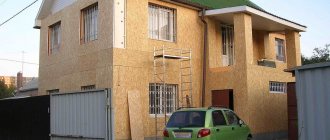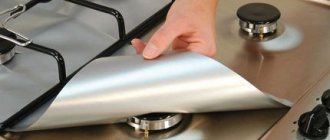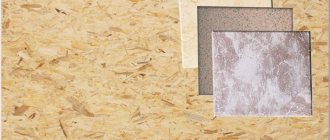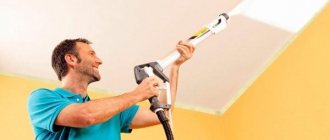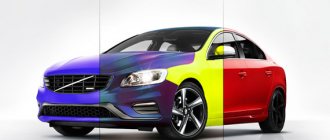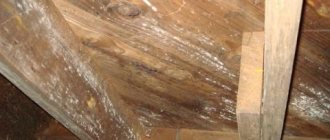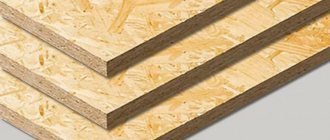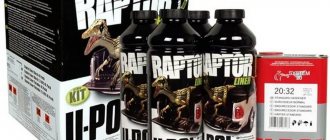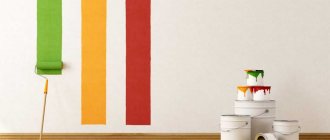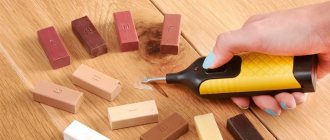In construction, a material such as OSB boards is often used. This product is lightweight and at the same time durable. OSB is also a fairly cheap and accessible material for the construction of various objects and the design of products made from it. In construction, the next stage after the actual construction of the structure is surface finishing. And, like all materials, the particle board must be well prepared for subsequent work with it. The most affordable and easy-to-handle material is considered to be a primer for OSB.
Purpose and application
The main purpose of the primer for OSB slabs is to level the surface, remove imperfections and hide joints. The product also prepares the surface for subsequent decorative finishing, such as wallpapering, painting or laying tiles.
Primer mixtures are used depending on their purpose. There are primers that can be used for finishing interior surfaces, as well as for exterior work.
What paints are used for OSB boards
A house covered with OSB boards requires attention and care. The easiest way to protect your walls is to paint them. You need to figure out which facade paint is best suited for OSB boards.
- Water-based compositions. This is the easiest paint to work with, the base is water. But it is not recommended to use it for processing OSB, since it does not adhere well to uneven surfaces. The base composition is white; to work, you need to tint the mass. You can do this in the store.
- Water-dispersion paint. Unlike water-based emulsion, the composition includes an additive - marble dust or chips. The price is more expensive, but the cost is justified. The coating is of high quality, textured. It perfectly hides the unevenness of OSB boards. To obtain a smooth surface, coatings without additives can be used.
- Alkyd compositions. Contains resins and weak acids providing excellent weather resistance. Due to the high flammability of both materials, OSB must be treated with fire-fighting agents before painting. Alkyd paint can only be applied to dry material.
- Oil paints. This is an accessible, cheap and simple finishing option, but currently the material is used extremely rarely. There are several reasons for this: oil paints are toxic, take a long time to dry, and last only a few years. Under the influence of atmospheric phenomena they quickly crack and crumble. It is difficult to work with them; they are applied only to a dry and smooth surface, otherwise streaks and drips will appear.
- Latex compounds. These are the most expensive finishing materials. Contains water, acrylic resin and various polymer additives based on polyvinyl, vinyl or silicone. They can be used for painting OSB boards, and you can get both a glossy and matte relief surface.
Advice! Paint for exterior use must contain additives that will protect the material from ultraviolet radiation. The paintwork material must be intended for processing wooden surfaces.
Composition and technical characteristics
The primer may vary in composition. The following types of product exist:
- Acrylic;
- Alkyd;
- Adhesive.
Important! Before performing work, you must familiarize yourself with each type of product. This will help you choose the most suitable material for OSB boards.
Consumption per 1 m2
When covering a well-prepared surface, the primer consumption per 1 m2 is 1 kg of mixture per 7-14 sq.m. The indicator may vary depending on the composition of the material and the absorbency of the surface.
Technology for painting OSB boards: instructions and video
What are the dyeing techniques?
When applying paint to OSB with a roller or brush, you may notice that some individual chips swell from moisture and rise.
This happens regardless of the type of material chosen. If you need budget finishing of the facade, then you can ignore these minor shortcomings.
However, if you need to complete all the finishing work as efficiently as possible, you should adhere to the following sequence of actions:
- priming the slab;
- installation of fiberglass mesh over the entire façade area;
- filling the surface with a frost-resistant and moisture-resistant composition;
- coloring.
When choosing elastic dyes, you can skip the puttying step - such paints will fit perfectly onto the fiberglass mesh and disguise it.
After applying the second layer, the OSB board will acquire a completely smooth and glossy surface.
The principles of preparing and painting OSB boards can be found here:
Peculiarities
The characteristics of the primer are different for each of the possible types. The acrylic mixture has such individual indicators as:
- This type of material contains acrylic polymers. They are completely harmless to humans and practically odorless. After applying the OSB, within an hour you can stay indoors without fear for your health.
- The mixture is diluted to the required consistency with plain water. Thanks to this, the material is easily applied to the OSB plane, and is also washed off without problems with ordinary water.
- Such mixtures come in different compositions. There are varieties of deep penetration acrylic composition. In addition, some manufacturers add antiseptics, which prevent the formation of mold. This product can be safely applied in damp rooms as well as outside.
- One coat of acrylic primer requires 1-3 hours to dry completely.
Important! Mixtures that are diluted with water cannot be applied at sub-zero temperatures. The water in the primer will freeze and the quality of the OSB surface will deteriorate.
Alkyd mixtures have the following features:
- Makes the OSB surface ideal for applying alkyd paint. This primer is also suitable for varnish coating. It is recommended to use such a product without fail, as it helps to significantly save the amount of paint;
- Helps make the surface stronger, regardless of the local location of the slab;
- This primer for OSB boards has antiseptic properties. A film is formed on the plane of the layer that does not allow water to pass through. Thanks to this, fungus and mold will not develop under the coating;
- A surface treated with an alkyd primer for OSB is not at all afraid of the ingress of various chemicals.
- Alkyd composition is used for processing not only metal and plastic, but also for wooden panels.
Adhesive primer for OSB is almost identical to others. The main feature is the presence of quartz sand in the composition. Due to this, the plane after processing with this material becomes rough.
Choosing a primer, what it depends on, the best options
The type of surface obtained directly depends on what decision the future buyer made. Each variety has its own characteristics, and operating conditions are also different.
Each variety has its own characteristics, and operating conditions are also different.
Acrylic primer
This treatment not only helps to strengthen the base. It brightens the product, creating an optimal basis for further application of wallpaper and any painting. With a starting price of 50 rubles, the solution became accessible to everyone.
Has the following set of characteristics:
- Drying at high speed. After two to three hours, work continues without problems. Air humidity and temperature determine exactly how much the process will take in a given case. When applied in cold weather, the water immediately freezes, so such work cannot be carried out;
- Using different formulation options. Some are suitable for indoor or outdoor use only. Other compositions add an antiseptic. Deep penetration compounds for general strengthening deserve a separate discussion;
- Easy to use. For dilution, ordinary water is used, so the materials are easy to apply and wash if necessary;
- Safety.
The materials have virtually no harmful odors, the same applies to negative effects on human health. 1 hour after treatment, you can be nearby and not worry about the appearance of negative factors if such a primer was used for OSB.
It brightens the product, creating an optimal basis for further application of wallpaper and any painting.
Alkyd primer
The danger of some components to human health are the only disadvantages noted by users. Work can only be carried out if there is good indoor lighting.
Among the positive qualities:
- Resistance to chemical compounds. Even when chemically active substances get on the surface, practically nothing happens;
- Presence of antiseptic properties. The appearance of fungus and mold is excluded, because water does not get inside;
- Increasing the strength of the original surface. Polymers in primer paint for OSB provide increased strength. Resistance to various types of damage also improves. Weather-resistant properties are of a high level. The material allows both external and internal use equally;
- Creating an ideal base for alkyd paints. Only this type of primer is suitable for those who plan to use alkyd paints and varnishes in the future. The consumption of the compounds themselves is one and a half to two times less.
Polymers in primer paint for OSB provide increased strength.
Adhesive primer
“Concrete contact” is an additional name for the primer for OSB boards of this type. It goes better with further puttying, plaster or wallpaper. The quartz filler in the composition increases the surface roughness. Putty with decorative plaster is laid on the walls in a layer of maximum strength. The compositions have good fixation and do not run off.
The primer promotes good adhesion between finishing materials. Allows you to create irregularities in different formats, which simplifies preparation for further processing.
Brushes and rollers with long bristles are most effective for application. Without thorough mixing before application, the distribution of materials over the surface does not occur evenly. The solution is optimal for liquid wallpaper or plaster over painted or varnished slabs. They can also be combined with a detoxifying primer for OSB.
The primer promotes good adhesion between finishing materials.
Advantages and disadvantages
Primer mixtures for OSB have the following advantages:
- Safe;
- Well levels the surface of the slab and isolates it from external negative influences;
- Protects against the appearance of fungus and mold;
- Dries quickly;
- Can be used for finishing surfaces indoors and outdoors;
- Whitens the slab well;
- Reduces the consumption of glue or paint for subsequent finishing.
Among the disadvantages, it is worth noting that not all types of primers are safe until completely dry. Also, the drying time may vary depending on the composition of the product, as well as on indicators such as temperature and humidity of the room.
paints and varnishes
0 votes
+
Vote for!
—
Vote against!
A fairly popular material in construction is OSB, oriented strand board, distinguished by its lightness, strength and affordable cost. But as you know, this production resource requires additional finishing, which allows the owners to realize the most extraordinary ideas in the design of buildings. Therefore, many non-specialized craftsmen have questions about what paint to paint an OSB board, what coatings to look for and what you need to know about them? More on this later in the article.
Table of contents:
- OSB - material features
- Is it possible to paint OSB?
- Stages of preparing the OSB surface for coating with paints
- Paint for OSB boards indoors
- Paint for OSB boards outside
OSB - material features
OSB is a material that consists of wood chip elements that are bonded together with waterproof synthetic resins. For their production, pressed equipment is used, which makes it possible to form slabs of three or four layers. In construction, OSB is used for different purposes, they are suitable for:
- construction of frame houses;
- indoor wall and ceiling cladding;
- installation of formwork;
- manufacturing of structural furniture elements, etc.
When properly manufactured, finished slabs are considered an environmentally friendly and safe product, which comes in several varieties. So, there are four OSB formats:
1. OSB-1 is characterized by low strength and moisture resistance, which is why this brand is most often used in the process of making furniture and carrying out interior work.
2. OSB - 2, with high strength indicators, is characterized by low moisture resistance, so this board is suitable for the production of partitions, etc.
3. OSB grade - 3 is a fairly durable and moisture-resistant material that is actively used in organizing external construction work.
4. OSB - 4 is considered the best resource in this category, due to its maximum moisture resistance, it is used to create roofs, walls of buildings, load-bearing elements, etc.
The strength and moisture resistance of the material depends on what percentage of the adhesive was used in the production process, as well as on the number of layers of pressed chips. As for the sizes of the slabs, they are standard: 122*244 cm, 122*336 cm, 125*375 cm, etc.
It is worth noting that oriented strand board has a low fire hazard and is not subject to processes such as rotting, delamination, and mold development. Its technological characteristics in many cases are superior to such wood resources as chipboard, plywood, and fiberboard. In addition, this material protects buildings well from excessive sounds, does not deform when in contact with water, and perfectly retains heat in the room.
Structures made from pressed slabs have a long service life. According to the recommendations of experts, owners buying OSB should check the certificates of construction products, since it is worth taking into account the fact that phenol, which is part of the resins, can harm human health, and its safe alternative, formaldehyde, is a worthy option. Therefore, it is better to buy materials with the Eco mark. Some of the world's worthy OSB manufacturers include the following brands:
- Norbord;
- Egger;
- Ainsworth;
- Glunz;
- Grant, etc.
It is worth noting that Chinese manufacturers offer products at a low price, but their quality is only suitable for external use.
Is it possible to paint OSB?
On the construction market, of course, there are oriented strand boards that are pre-coated with paint and varnish, but their cost is much higher than the pure resource. But still, most often, owners purchase those sheets that require additional processing during the process and for this purpose they use various varnishes, paints and other similar means that allow them not only to extend the service life of OSB, to add harmony to the appearance of the building, but also to hide unevenness chip texture of the material. Paint for OSB boards, the choice of which is based on several important rules, can be of any color, the main thing is that it does not contain harmful pigments. So, see the table for the types of coatings.
| Types of paint coatings | ||
| oil | acrylic | alkyd |
| This variety is considered an ideal option for painting OSB, due to the high level of viscosity of the product. This allows the coating to lie flat on the surface of the slab and not be strongly absorbed into the wood texture itself. The disadvantage of this type of painting is the long drying period, but this does not mean that the result will be bad. Oil paints allow you to obtain an impressive protective layer. | Painting OSB slabs with acrylic paint is considered a very profitable option, since this type of coating does not require additional finishing and allows the slabs to serve their owners for a long time. These products carefully hide irregularities in the chip material and create even color tones. If acrylic coating is provided on external walls, it reliably protects the wood from mold. | Alkyd enamels are a coating that penetrates deeply into the OSB structure, resulting in a high-quality, durable finish that significantly extends the service life of pressed boards. |
Various antibacterial impregnations are also actively used for processing OSB, which makes it possible to give the material a tinted effect. It is worth saying that in order for an OSB board painted with paint to look natural and not lose its original characteristics, it is necessary to take into account the characteristics of the wood resource, composition, base of the coating and properly prepare the surface for processing.
Stages of preparing the OSB surface for coating with paints
If you apply paint directly onto the wood board itself, without pre-treatment, the material may swell and lose its ideal original appearance. Finishing and painting construction resources is a whole technological process in which, in order to achieve ideal results, it is necessary to act in stages. So, before purposefully using paint, it is necessary to prepare the OSB surface.
1. To ensure that the wood material does not absorb excess primer and paint, you need to grind the surface, which will smooth out uneven textures. At this stage, the master will need a special tool - a grinding machine. Particular attention should be paid when sanding boards of grades 3 and 4. If the OSB does not show any special violations in the structure, then you can get by with ordinary sanding paper.
2. At the next stage, they work with places that form rough irregularities on the slabs, most often these are joints, areas where screws are used, etc. To do this, craftsmen introduce special oil-adhesive compounds, putties, decorative strips, etc. into the work process.
3. The next working stage involves applying the primer layer. To do this, you will need varnishes with an acrylic or acrylic-polyurethane composition. Wide brushes are best for applying it. The product must be applied evenly over the entire area of the slab, slowly.
4. Paints for OSB boards can be purchased at any hardware store, after which it is recommended to work with them using generally accepted technology. The essence of working with such products is to apply several layers, while their density increases in the area of \u200b\u200bthe edges. It is worth considering that the movement of the brush should be performed in one direction. The slab panels must be dried at a stable temperature, strictly neutralizing drafts.
It is necessary to remind the following nuance that for alkyd enamels the painting stage is considered the last, since they do not require additional finishing. But in the case of oil and acrylic, a varnishing process is also added, which allows you to obtain the most durable surface.
Paint for OSB boards indoors
As practice shows, a wide variety of materials are used to paint a room from the inside. And this is not prohibited, the main thing is that the owner is confident in their safety, and for this he must request the appropriate quality certificates when purchasing, and also be interested in the composition of paint products. Also, when choosing a coating, it is worth considering the time that the owner has to carry out repair work. After all, as you know, for example, oil paints are characterized by the property of taking a long time to dry, but are considered a worthy option for decorative finishing of a room.
In comparison, alkyd enamels dry quickly and do not require additional varnish treatment, which means that this product is suitable for those who want to quickly finish the interior decoration of rooms. Painting an OSB board indoors with acrylic paint results in a surface that can be both cleaned and washed. It is not recommended to use ordinary water emulsion for finishing OSB. For oriented strand boards, products based on organosoluble pigments are best suited.
In the process of painting pressed wood material, craftsmen will need tools such as brushes, rollers, and spray guns (to perform a large amount of work). Before spreading the paint material around the entire perimeter, it is best to first paint a small area of the slab, evaluate how smoothly the chosen product lays down, when purchasing which you need to clarify whether it is suitable for wooden surfaces. When additional treatment with varnish compositions is applied, applying several layers, it is necessary to maintain a time period of at least 12 hours. It is also necessary to say that paints are applied to the OSB surface in unlimited layers until a 100% monochromatic effect is obtained.
Paint for OSB boards outside
Facade paint for OSB boards can also be of a varied nature. Along with oil, acrylic and alkyd coatings, products containing latex polymers can also be used. Products containing alkyd resins are characterized by good waterproof and rust-resistant properties. It is paints from this category that will be able to reliably protect OSB from the outside, since they are characterized by frost resistance, low abrasion, etc. Equally important is the low toxicity of this dye. If the master decides to use alkyd paints, he has the opportunity to choose colors from a wide range of matte and glossy enamels. It is worth remembering that it is recommended to apply this group of paints to a dry, clean wood surface.
No less in demand for external OSB treatment are acrylic products, the distinctive feature of which is the high level of water in the composition. They are absolutely practical and, when used and applied correctly, do not actually cause swelling of the slab. This type is recommended to be applied slowly, in small quantities, this will allow the water molecules to evaporate faster. It is worth noting such facade materials as silicone water-based compositions, because their advantages are considered to be: anti-flammability, vapor permeability, as well as a high level of adhesion, in addition, most of them are characterized by antibacterial properties.
Thus, we can conclude that the choice of paint material for OSB is a choice that strictly concerns the owners, based on the available budget and the purpose of the construction project. The main thing is for craftsmen to remember that OSB is still a raw wood resource that requires special care and should not be subjected to unnecessary exposure to high levels of moisture. Therefore, any oil, acrylic, alkyd and other compositions, if properly selected and applied, will be good protection for a structure made of oriented strand board. For more information on the topic, watch the video:
Preparing the surface for further decoration
Before you begin the actual design of the surface, it is necessary to carefully prepare it. The technology for pre-treatment of surfaces may differ depending on the type of material that is planned to be used in the future.
Under wallpapering
You shouldn’t just glue wallpaper onto bare OSB boards. You must first do the following:
- Using putty, attach the mesh to the joining seams. It will make the slab level and all hints of joints will disappear.
- Dilute the OSB primer according to the instructions and apply an even layer. Allow the material to dry completely.
- Once the primer is dry, you need to apply the putty as evenly as possible. Let this product dry too.
- When the putty has completely adhered to the surface, it must be processed using sandpaper. This will make the surface smoother.
- Next, you need to make another layer of OSB primer and make sure that the surface is smooth without protruding elements. If they are present, such as small pieces of primer sticking out of the wall, then they should be removed with sandpaper and another primer coat done.
- After the surface has completely dried, you can decorate the particle board with wallpaper. Wallpaper is glued in the usual way.
Important! Applying a primer for wallpapering on OSB is a must. The fact is that this product will provide good adhesion between the wallpaper and the wall.
For painting
Simple painting of slabs always ends with uneven application of the paint material and the presence of visible stripes. This can easily be avoided if you do the following preliminary work:
- Cover all joints with putty or seal with foam. After drying, the foam needs to be cut off so that it becomes flush with the plane.
- Apply a layer of putty to the surface. This will help completely hide all the joints.
- If the wall is not planned to be textured, then it must be sanded well. Then apply a layer of primer, carefully ensuring uniform application. For a better effect, it is recommended to do two layers of primer.
- Paint the wall with a roller. It is important to apply paint to the entire surface area at once. If you interrupt during work, some areas will dry faster. And you will get stripes.
Advice! To avoid streaking, it is recommended to apply two coats of paint. The first one will simply create the color. The second one can level it.
Using the same principle, you can paint and prime the ceiling and walls.
Under the tile
The tile will adhere well only to a pre-treated surface. Bare application will cause the tile to peel off from the plane. To prevent this from happening, it is enough to cover the surface with two layers of primer mixture for OSB boards.
You may not achieve perfect application and leveling of the surface. The main thing is that the tile has something to cling to. It is recommended to pre-cover the joints with putty.
Using OSB boards
Now, due to their unique qualities, OSB boards (OSB or OSB) are beginning to become popular.
In construction they are used in the following cases:
- Laying the floor. OSB has a strong and even base, so they can be laid on concrete and then laid on top of linoleum, porcelain tiles or laminate. The slabs can also be used as a subfloor. OSB can also serve as a base for pouring self-leveling concrete mortar.
- They play the role of partitions indoors, and are also painted with any varnish or trimmed with wallpaper.
- They are used as external walls and partitioning elements. Then they are decorated with varnishes and paints for external work.
- Since OSB is a durable coating, it can be used as a continuous roof sheathing. They can withstand even heavy snow.
- Furniture manufacture. Only one restriction applies to such furniture items - direct contact with moisture should not be allowed.
- Various containers are made from OSB.
Oriented strand boards - 3 are very popular, as they are universal in use. They are used to make sandwich panels for the rapid construction of cottages. Paraffin or wax is applied on top of the slabs, giving this material moisture-repellent qualities.
But for this reason, oriented strand board is not easy to paint. The paint and varnish material does not adhere to paraffin and flows.
Wallpapering without preliminary preparation of the coating can also end in failure.
Tips and recommendations for use
When working with OSB primer, you should rely on a single correct algorithm for applying the material to the surface. It looks like this:
- Surface cleaning. Before applying the primer, the slabs must be thoroughly cleaned of dust and dirt. It is advisable to walk with a slightly damp cloth over the entire surface of the OSB.
- Sealing joints osb. The joints can be sealed either simply with putty or with acrylic sealants. Quite often, polyurethane foam is used for these purposes. In any case, after the product used has dried, its excess is cut off or sanded with sandpaper.
- Preparing the mixture. The primer composition must be thoroughly stirred before use if it has already been prepared. If it is a dry mixture, it must be diluted with water in accordance with the instructions.
- Applying primer to osb. From the very beginning it is worth treating all joints with the composition. Then apply two layers of primer. It is important that several hours pass between applying layers, during which the first layer can dry.
Using the same algorithm, you can use a primer layer for OSB panels on the outside.
It is also worth paying attention to the importance of mixing the primer immediately before application. This is especially true for the adhesive type. This mixture contains quartz sand, which, as a rule, precipitates when the mixture sits for a long time.
How to choose finishing materials
Finishing work on OSB boards must be carried out taking into account special requirements.
Specifics of priming
Before applying the putty, sand and then prime the surface.
Sanded OSB panels are available on the construction market. Their price is a little higher, but it is justified by the fact that it eliminates the need to spend your own time and effort preparing the slabs.
Not just any primer is used, but only one that is specifically designed for treating wood. These mixtures contain no water. A primer based on drying oil or glyphthalic varnish is ideal.
Advice! The end parts of the panel are characterized by the greatest vulnerability to moisture. These places must be carefully treated with a primer before installing the slabs, otherwise it will not be possible to do this later.
Selection of putty
Processing OSB boards is possible only with special means. If the putty is intended for other purposes, for example, for work on concrete, then it is probably not suitable for wood.
The following mixtures, commercially available in ready-made form, are used for working with wood:
- Acrylic putty for OSB boards. It is used for leveling any wooden bases, also suitable for wood-chip surfaces.
- Nitro putty. This is a composition that dries quickly, made from cellulose and resin with the addition of plasticizers, organic solvents and fillers. As a suitable solvent, grades R-645 and R-649 can be used. The best nitro putties can be called MBSh, ASh-24, ASh-32.
- Oil and glue based putties. They consist of drying oil, varnish, adhesives, chalk, modifiers and thickeners. Drying oil is suitable as a solvent. The most common oil-adhesive mixtures are LSh-1, LSh-2.
- Adhesive composition. As a base, glue of a more liquid consistency is used - oil. Plasticizers are present as additional ingredients.
- Gypsum putty. Consists of gypsum with polymer additives. Gypsum-based mixtures are most suitable for wooden bases. Of the putties of this type, the most famous brands are Vetonit, Rotband, Goldband.
- Dispersion mixture based on artificial resin. Experienced builders consider the German putty Akkord-Finish AS 5 to be one of the best. It is characterized by excellent ductility and is used as a finishing mixture when finishing a plastered base.
Review of popular manufacturers
Among the manufacturers of primer mixtures for OSB, the following are noted:
- Master Inter. This is a universal primer. It can be used not only on wood, but also applied to concrete bases. Well suited for painting and wallpapering. It gives not only an attractive appearance to the surface, but also acts as a binding layer for subsequent finishing.
- Kreisel 301. This primer mixture is universal and suitable for almost any surface, in particular OSB. It belongs to deep penetration materials. Thanks to this, the layer is smooth and sits well on the surface.
- Moment GROUND. A universal primer mixture that fits well on OSB boards. After hardening, tar stains will not appear on its surface, which happens with the coating of wooden surfaces.
- GF-21. Special primer for wooden surfaces. This product performs all the standard functions of a primer, and also additionally protects the OSB surface from fire.
Types of OSB
OSB boards can be divided according to different criteria. This is the level of moisture resistance and strength, the presence of locking joints, the environmental friendliness of the material, and the thickness of the sheets.
There are several types of OSB. And not all of them are equally suitable for interior decoration.
According to their physical and technical characteristics, oriented strand boards are divided into four types. Each of them has its own purpose. Therefore, when purchasing building materials, it is necessary to take into account the conditions under which they will be used.
- OSB-1 does not have high strength and moisture resistance. Therefore, they are usually used as auxiliary material. Their cost is low, and they are often used, for example, to create temporary formwork. After dismantling it, it will not be a shame to dispose of the used parts.
- OSB-2 - characterized by fairly high strength, but not outstanding moisture resistance. As a construction material, they can only be used for interior work and exclusively in dry rooms. Suitable, for example, for covering light partitions in a room.
- OSB-3 are products that can be called universal. The boards are used both in dry rooms and in conditions of high humidity, including outdoors. They cover walls, form interfloor ceilings, and lay rough and “clean” floors for decorative coverings. They are often used as a material for continuous sheathing under some types of roofing coverings.
- OSB-4 - products with high moisture resistance and excellent strength. Therefore, they can be used in various fields of construction, including to create self-supporting loaded structures.
We recommend: How to choose a primer for mold and mildew?
The slabs are most often produced in sizes 1250×2500 or 1220×2440 mm. Thickness range – from 6 to 25 mm. There may be other dimensions in length and width - this is worth paying attention to. Sometimes non-standard sizes allow you to choose the best option for a specific coverage area. That is, they make it possible to avoid a large amount of waste when cutting material.
OSB boards can be regular or tongue-and-groove.
Oriented strand boards are often produced with straight ends. But for finishing work, you can also look for tongue and groove ones.
- Conventional OSB sheets have smooth edges. When covering surfaces at joints with them, it is necessary to maintain a technological gap of 3–5 mm, which will keep the coating intact during thermal expansion of the material. Such slabs must be rigidly fixed to the base using self-tapping screws screwed in at intervals of 350÷400 mm. It is recommended to fasten large OSB sheets not only along the perimeter, but also additionally along the diagonals.
Tongue-and-groove OSB boards allow for a virtually seamless covering.
- Tongue-and-groove slabs are equipped with a tongue-and-groove joint. This option is more convenient when the slabs are planned to be used as a finishing coating, including for further painting. The joints are more accurate, and the gaps between the plates are practically invisible. When attaching tongue-and-groove OSB boards to a flat base, you do not have to use many screws. In addition, the products can be used for floating coating when installed on a concrete base.
Another important criterion for choosing OSB boards is the materials used in their manufacture. This parameter is especially important if the slabs are purchased for covering surfaces inside residential premises.
Formaldehyde resins can be used as a binder for wood chips, which release toxic fumes into the environment. Such materials have a formaldehyde emission class of E2 and higher, and are not suitable for internal use.
OSB boards produced according to European standards and marked “ECO” or “GREEN” are suitable for this application. The production technology excludes the presence of toxic compounds in the material. Wood raw materials are pre-treated with paraffin-wax impregnations, and polyurethane resins are used as a binder, which after polymerization become completely harmless to the environment.
The level of formaldehyde emission is indicated by the assigned class. E1 can be considered acceptable for residential premises, but E0.5 is better. And the best option is the already mentioned above “ECO” sign.
This option is fully suitable for residential premises. And it can be safely used for painting.
The certificate of conformity must indicate the formaldehyde emission class. For interior work, it should be no higher than 1, but better than E0.5 or “ECO”.
But in order to guarantee the “purity” of the material, when choosing it, you must carefully study the markings on the sheets. And this information must be confirmed by a certificate of quality (conformity), presented by the seller at the buyer’s request.
Paint selection
When choosing paint for interior decoration, the following factors are taken into account:
- type of wood pulp and polymer included in the particle board;
- type of decoration;
- characteristics of the room.
Before painting the OSB board inside the house, you should consider the main characteristics of commercially available LCS.
Oil paint
This type of material is rarely used due to its disadvantages: it takes a long time to dry, quickly loses its original appearance, and contains toxic substances. Most often, this paint is used to cover OSB floors or ceilings in the country.
Alkyd
A universal product, an alternative to oil formulations. Enamel penetrates deeply into the structure of OSB tiles and increases its service life.
Water-dispersed
This coating is not recommended for painting plywood. The coloring mixture, in addition to pigment and polymers, contains water, which deforms the layer.
Latex
This type of water-based paint contains latex. Eco-friendly and durable dye.
Varnishes, impregnations
They protect the surface from external influences. Aqualak applied over the paint will add an even glossy tint to the base color or emphasize the texture of the slab.
Impregnation for this type of building material should be based on resin solutions. Such mixtures are good at preventing the appearance of lignin (yellow spots).
Alkyd impregnation is incompatible with latex.

